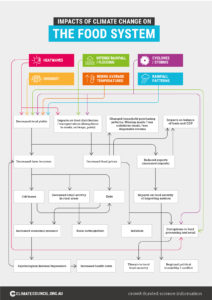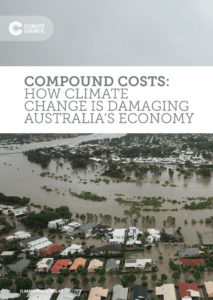The Climate Council’s report, ‘Compound Costs: How Climate Change is Damaging Australia’s Economy’, finds there are few forces affecting the Australian economy that can match the scale, persistence and systemic risk associated with climate change.
Australia’s financial regulators have recently made a call for action to deal with climate change, with the Reserve Bank of Australia, the Australian Prudential Regulation Authority and the Australian Securities and Investment Commission citing risks posed by climate change as a central concern for the economy and financial stability.
As the Deputy Governor of the Reserve Bank of Australia noted, the risks that climate change poses to the Australian economy are “ first order” and have knock-on implications for macroeconomic policy (Debelle 2019).
DOWNLOAD THE REPORT
Key Findings:
1. Climate change is a major threat to Australia’s financial stability, and poses substantial systemic economic risks.
- Direct macroeconomic shocks from climate change, including reduced agricultural yields, damage to property and infrastructure and commodity price hikes, are likely to lead to painful market corrections and could trigger serious financial instability in Australia and the region.
- Australia’s financial regulators acknowledge that climate change is now a central concern for the economy and financial stability.
2. Detailed new modelling, based on the Federal Government’s current approach to climate change, finds that the economic damage to Australia’s property and agricultural sectors will be very significant.
- Australia’s greenhouse gas emissions have been rising for four years and we are not on track to meet our weak 2030 emissions reduction target. If the world followed Australia’s approach we would be on track for at least 3-4°C of global warming, which would have catastrophic economic consequences.
3. The property market is expected to lose $571 billion in value by 2030 due to climate change and extreme weather, and will continue to lose value in the coming decades if emissions remain high.
- One in every 19 property owners face the prospect of insurance premiums that will be effectively unaffordable by 2030 (costing 1% or more of the property value per year).
- Some Australians will be acutely and catastrophically affected. Low-lying properties near rivers and coastlines are particularly at risk, with flood risks increasing progressively and coastal inundation risks emerging as a major threat around 2050.
- Certain events which are likely to become more common because of climate change are not covered by commercial insurance, including coastal inundation and erosion.
- More than $226 billion in commercial, industrial, road, rail, and residential assets will be at risk from sea level rise alone by 2100, if greenhouse gas emissions continue at high levels.
Want to be the first to receive our reports about climate change? Join the Climate Council today.
4. Extreme events like droughts, heatwaves, cyclones and floods have an impact on agriculture and food production; this is already affecting Australia’s economy and will cost us much more in the future.
- Climate change is increasing the severity and intensity of extreme weather events in Australia.
- On current trends, the accumulated loss of wealth due to reduced agricultural productivity and labour productivity as a result of climate change is projected to exceed $19 billion by 2030, $211 billion by 2050 and $4 trillion by 2100.
- By 2050, climate change is projected to halve the irrigated agricultural output of the Murray-Darling Basin region, which currently accounts for 50% of Australia’s irrigated agricultural output by value (about $7.2 billion per year).
- By 2090, wheat yields on the 4,200 family farms in WA that produce half of Australia’s wheat are projected to fall by 41-49% if greenhouse gas emissions remain high.
- Previous severe droughts have reduced Australia’s Gross Domestic Product by around 1%; estimates suggest that increasing drought frequency and impacts in the future may reduce GDP by 1% every year.
5. The severe costs of climate change outlined in this report are not inevitable. To avoid the costs of climate change increasing exponentially, greenhouse gas emissions must decline to net zero emissions before 2050. Investments in resilience and adaptation will be essential to reduce or prevent losses in the coming decades.
- Increasing resilience to extreme weather and climate change should become a key component of urban planning, infrastructure design and building standards.
- Buildings and infrastructure must be built to withstand future climate hazards and to facilitate the transition to a net zero emissions economy.
- A credible national climate policy is needed to safeguard our economy by reducing the direct costs of climate change, and avoiding economic risks associated with a sudden, disruptive or disorderly transition to net zero emissions.
Property impact modelling was provided by XDI Systems.
DOWNLOAD THE REPORT

